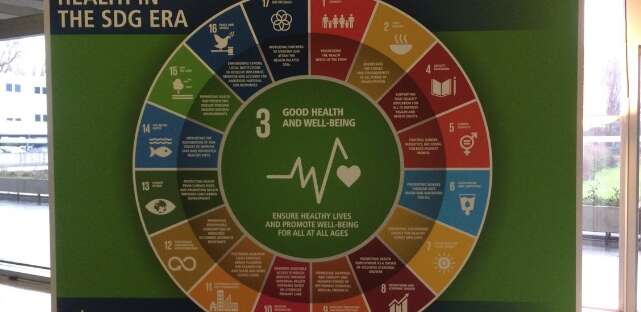
By Professor Russell Stothard
29th November- 2nd December, 2016
It was inspiring to walk into WHO-Geneva each day and see the Sustainable Development Goals on display. With 2020 only three years away, it was timely to spend the last three days in discussion with colleagues about the current progress towards control and elimination of schistosomiasis and soil-transmitted helminthiasis. There was also ample time to look forward to 2030 and think more creatively about linking up intersectoral actions and how to maintain the success of those interventions that are doing well. A major concern within the STH community was ensuring that after GPELF (Global Programme to Eliminate Lymphatic Filariasis) activities have ceased there will be continuation of the community-based platform for delivery of key anthelminthics, albendazole and mebendazole, to reach those with STH.
In discussion of STH, it was thought that better surveillance of strongyloidiasis was needed, also ensuring that ivermectin, the current drug of choice, is placed on the essential medicine list and made available to those that need it at various points within the health system. More broadly, treatment of preschool-aged children has been ongoing well, expanding slightly better in treatment coverage than that for school-aged children. Ways to reach at-risk adults with treatment, especially women of child bearing age (WCBA), was discussed along with safe use of anthelminthics in general during pregnancy, making reference to praziquantel and associated studies.
With regard to schistosomiasis, it was clear that it was time to think in two different ways, gaining, controlling and progressing towards elimination; and what goes on in the environment. This schism of logic has some difficulties as the transition from one to the other raises several challenges in application of the existing guidelines and surveillance. We all agreed it was easy to get confused, mixing concepts and resources. However, it was pleasing to see that the use of the urine-CCA test for detection of Schistosoma mansoni has been rolled out by WHO-AFRO and now used at-scale in mapping disease distribution. This has made specific reference to our previous work undertaken at the LSTM and before as seen here.
Basic disease mapping is fundamental in getting a country started on the road towards control as it allows the country to request appropriate stocks of praziquantel. It then later permits some geographical targeting of resources to the endemic area, hoping that this will draw attention to future access to treatment at the primary health care level where it was once previously overlooked. It was pleasing to see WHO take evidence-based steps to provide interim advice with revised guidelines which will allow many to have treatment in future.
Current treatment strategies are known to have problems largely resultant from when guidelines were first set as praziquantel had to be purchased. With the expanding donation from Merck-KGaA there is now scope to expand access by changing prevalence thresholds and treatment cycles. It was fortunate that Nathan Lo’s paper in The Lancet Infectious Diseases was published on the same day as these discussions. Without doubt this will later contribute evidence towards more formal revision in the coming years. I was delighted to also point out in a presentation to the group that biannual treatment is needed in certain places allowing interventions need to be intensified and drew attention to recent research in Cameroon looking at transmission hotspots in Barombi crater lakes. To a schistosome, the concept of an ‘annual calendar’ of treatment once a year only, likely makes no sense for it can complete its lifecycle and cause disease in a much shorter period of time. Even shorter treatment cycles of every three months were discussed for special cases.
Attending this meeting also coincided with World AIDs Day on the 1st December where a free testing stall demonstrated rapid diagnostic tests in the reception area. HIV was also discussed in the meeting with specific focus on Female Genital Schistosomiasis (FGM) and made reference to our earlier meeting in South Africa in January 2015 from which we wrote a review. There was a particularly touching presentation given by Dr Eryun Kjetland who highlighted that FGS is simply overlooked by many in Africa yet should be included in routine differential diagnosis (and treatment) for millions of African women. We should all look forward to a better health system that can tackle this disease with an appropriate response which should go some way to halting the HIV epidemic in sub-Saharan Africa.
(You can find Prof. Stothard’s presentation at the meeting here)
